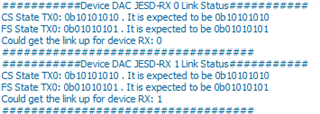Other Parts Discussed in Thread: TSW14J58EVM
Tool/software:
I am now working with the PAP function of AFE7901/7903. It is started with basic configuration, not far away from the default setting.
But it always disabled the output signal, no matter how low the signal it is.
Could you please advise? For example, provide a PAP configuration template?
Thank you very much.






